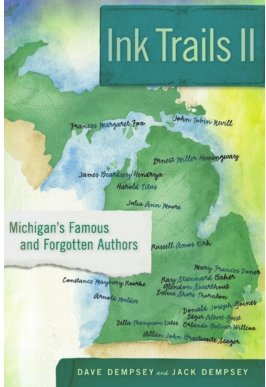
A review in the January 21, 1960, edition of the State News said of MSU Professor Glendon Swarthout’s ”Where the Boys Are,” “It’s a funny book and a serious book and gets some important things said.”
Oh, it did more than that. Swarthout’s novel about a group of students reveling during spring break in Jacksonville, Fla., is credited with helping create the national phenomenon — or bacchanal — of spring break that we know today.
By the time Swarthout became popular as the author of “Where the Boys Are” in the 1960s, he was already an established writer of Westerns. Two of his books, “A Horse for Mrs. Custer” and “They Came to Cordura,” were made into successful movies.
“’Cordura’ is a beautiful meditation of what courage is,” Dave Dempsey said.
Swarthout is one of 17 Michigan authors profiled in a new book, “Ink Trails II: Michigan’s Famous and Forgotten Authors,” by brothers Dave and Jack Dempsey. It is the duo’s second book on Michigan’s lesser known authors.
The authors will talk about their new book, with special emphasis on authors with connections to Lansing and East Lansing, at 7 p.m. April 28 at the Library of Michigan. The event is sponsored by the Library of Michigan and the Historical Society of Greater Lansing.
Other authors and poets covered in the book with ties to mid-Michigan include Ray Stannard Baker, a Pulitzer Prize winner and Michigan Agricultural College graduate; Emma Shore Thornton, an MSU professor in American thought and language; and conservative writer Russell Kirk, who graduated from Michigan State College and later taught at the university.
Baker, who wrote under the pseudonym David Grayson, became known for his nine volumes of fictional rural life stories, filled with tales of manual labor, beekeeping, and farming. MSU Library Special Collections holds some of Baker’s rare beekeeping books.
Baker, writing as Grayson, lived something of a double life in literature. While he wrote fiction as Grayson, Baker was also one of the nation’s leading muckrakers. He often wrote of the downtrodden and about unpopular issues such as lynchings and Jim Crow laws. He was a buddy of President Theodore Roosevelt and wrote the multi-volume “Woodrow Wilson: Life and Letters,” which garnered him the Pulitzer Prize in 1940. Baker and his spouse, Jessie Baker, spent considerable time in East Lansing, and he was one of the founders of the Peoples Church.
In his chapter on Baker, Jack Dempsey points out that the author has been forgotten largely due to circumstances that had nothing to do with his writing.
“Baker’s subjects did not have staying power,” Dempsey said. “Wilson’s presidency has fallen from favor in the rankings of historians, and Grayson’s bucolic theme faded as the depression tore away any romance in the poverty felt in rural America.”
The book profiles Ernest Hemingway, as well as Alan John Braitwaite Seager, who the authors call the “forgotten Hemingway.” While Hemingway fans may have an issue with lumping Hemingway in with the forgotten authors, the Dempseys felt they couldn’t omit the literary giant.
“We at first resisted it, but he’s a Michigan brand,” said Dave Dempsey. “You could say it was in response to popular demand.”
The book also includes two authors, James Beardsley Hendryx and Harold Titus, who were environmentalists. Dempsey notes that Titus’ 1922 novel, “Timber,” was considered the “first novel of conservation anywhere” according to a leading conservationist of the time. The novel is a thinly disguised protest against clear-cutting and a call for reforestation, all wrapped around a boy-meets-girl tale. The silent film “Hearts Aflame,” based on “Timber,” was shown to the Michigan Legislature in 1922 to make the case for better forest fire protections.
Hendryx, a prolific writer of gold rush adventures, was also an avid hunter and fisherman. He fell in love with Michigan on a fishing trip hosted by Titus. Both authors lived in the Traverse City area for several years.
Another writer, Donald Goines, wrote about the underbelly of America — drug addicts and criminals — in his incredibly popular urban novels. Books such as “Whoreson” and “Dopefiend” take place on the streets of Detroit.
“Donald Goines wrote 16 uncompromisingly gritty novels arising from those grim avenues,” Jack Dempsey writes.
Goines completed those 16 novels in only four years, from 1971 to 1974. He and his spouse were found shot dead in the couple’s apartment in 1974; the killer was never found.
“Goines dealt with a harsh reality in urban Black America and unquestionably set the table for rap/hip-hop,” Dempsey said. “There was tragedy in the lives of both Baker and Goines, but they should be remembered for their roles in telling important stories of Michigan and the excellence they brought to those efforts.”
So why do we forget our Michigan authors? David Dempsey suspects our Midwestern values play a role.
“We are kind of humble,” he said. “Michigan is too modest about its literary heritage.”
“Ink Trails II”
Meet the authors event 7-8 p.m. Thursday, April 28 FREE Library of Michigan 702 Kalamazoo St., Lansing (517) 373-1300, michigan.gov/libraryofmichigan
Support City Pulse - Donate Today!
Comments
No comments on this item Please log in to comment by clicking here